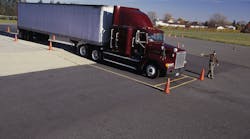There is a lot of conversation about the importance of company culture these days, especially around creating a "safety culture." But something is missing from that conversation, and that's how a company's training program can either reinforce the positive aspects of your culture, or systematically destroy it.
Driver training impacts how a driver feels about your company more than you might perceive. Think about it. The very first thing drivers’ do at your company is to attend orientation training and the first impression is going to be through that lens. What your trainers say and how they interact with a new group of hires is extremely important to both new hires and the company itself.
And, what about after orientation? How is training conducted after a driver has been at a company for 6 months? A year? 5 years? Is there any training after orientation? Or does training only occur after a driver has had an incident (what we like to call "training as punishment").
How a company approaches driver training can tell you a lot about its culture and how drivers feel about working there. Through the Best Fleets to Drive For program, we ask drivers every year whether or not training is important for drivers to succeed. 71.8 percent strongly agree that it is. But how many companies actually look at how their training program supports drivers, or whether the drivers are getting anything out of it?
How do you determine whether your training program is a culture-killer or a culture-builder? It starts by determining how, when and why drivers are trained.
Here’s an example of a culture-killer: A driver has an incident – he may have backed into the loading dock, doing some small damage to the trailer. The driver is then automatically assigned training for backing. The idea of automatically assigning training when a driver has an incident sounds like a great time saver. But it can hurt you in the long run. Sometimes, an incident is not due to a lack of knowledge and unless there is a conversation with the driver, you won't ever know. In fact, you are missing an opportunity to connect with drivers and provide support that will make them feel like your company is home.
Training needs to be for the right reason. Proactive training (not reprimand) provides information to help drivers become better and safer at what they do. It also supports the company culture and can become a valuable tool for retention. When people know how they fit in, and what is expected of them, they are generally more satisfied with their jobs. What’s more, through one-on-one coaching or classroom training, you have a valuable opportunity to find out how the driver is doing. Even when the training is online, track the results and when you see someone is struggling in a certain area, follow up and provide extra support. This is a culture builder.
Another builder is compensating drivers for training. Since most drivers are only paid when they’re rolling, taking part in training during off-hours shouldn’t be taken for granted. Unpaid training does nothing to make drivers feel like they are a valued part of an organization. Since drivers are not typically paid a salary and they don't get home very much, giving up personal time can seem punishing.
There are number of ways training can help your organization if it's done for the right reasons at the right time and for the right audience. It brings people together through discussions, cross-training and collaboration opportunities. It also helps people succeed in their jobs because they understand how the company works and their place in it. It keeps your drivers safe by providing information on best practices. It connects your company to your drivers by providing an opportunity to ask questions and give thoughts and opinions in a positive environment.



